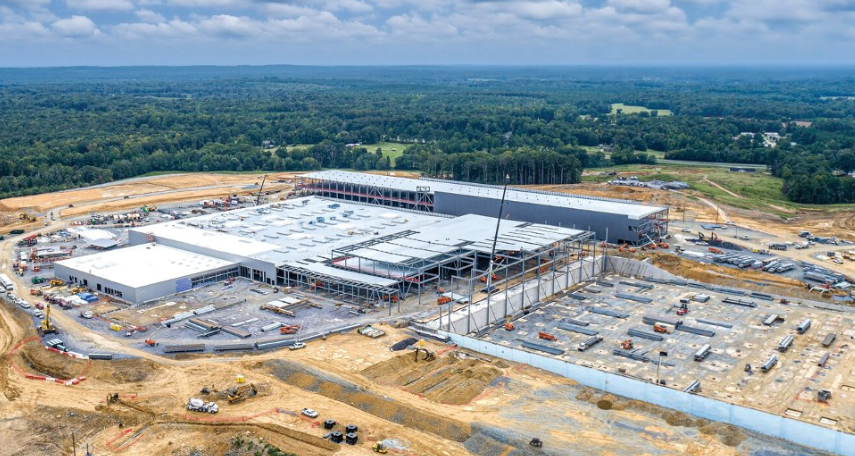May 17, 2024
8 Minute Read
DDC Journal: Building & Producing With Speed

Leading Semiconductor Company Builds World’s Largest Silicon Carbide Materials Manufacturing Facility In North Carolina
Wolfspeed, a semiconductor industry leader, is using the latest technology and construction methodologies to create a first-of-its kind materials manufacturing facility in Siler City, North Carolina. The John Palmour Manufacturing Center for Silicon Carbide will allow the company to build on its 35-year legacy of cutting-edge semiconductor technology by maximizing its production of silicon carbide wafers.
Wolfspeed (formerly known as Cree and Cree Wolfspeed) is leading the transformation from silicon to silicon carbide and gallium nitride (GaN) in the semiconductor market. The company’s products are used in evolving industries-powering technologies like electric vehicles, 5G networks and renewable energy storage. Its silicon carbide materials themselves are also more sustainable, doing more by using energy more efficiently than traditional semiconductors. Demand for these products continues to grow rapidly.
To address supply constraints, Wolfspeed is embarking on a $6.5 billion capital expansion program that will solidify its industry-leading position and increase its product manufacturing capabilities. Five investments are committed through 2027, including Wolfspeed’s newly opened Mohawk Valley Fab in New York-the world’s first fully automated 200mm silicon carbide fabrication facility. The John Palmour Manufacturing Center for Silicon Carbide is another, giving Wolfspeed the capacity to ramp up 200mm silicon carbide wafer production to supply Mohawk Valley Fab.
“This project is a step forward in our manufacturing capabilities that supports our materials business,” says Chris McCann, Vice President of Global Project Management at Wolfspeed. “It is going to increase our capacity by 10 times our current capacity we have at our Durham campus, which is the focus of all of our materials business at this time.”
A CUTTING-EDGE FACILITY
The John Palmour Manufacturing Center for Silicon Carbide will be the largest silicon carbide materials manufacturing facility in the world. At full buildout, the facility will span more than 2 million square feet on its 445-acre site in the Chatham-Siler City Advanced Manufacturing (CAM) site, a 1,802-acre industrial park in Siler City.
“It’s a first-of-its-kind project. There’s no other facility in the world like this one,” McCann says. “There are big facilities in the world, but (as far as facilities that do what we do and will manufacture what this facility will, there’s nothing else like it in the world.”
The facility will primarily focus on producing 200mm silicon carbide wafers, which are 1.7x larger than 150mm wafers — meaning more chips per wafer and lower device costs for consumers. This approach is critical to Wolfspeed’s long-term growth strategy, helping it accelerate the adoption of silicon carbide semiconductors and increase market supply. In keeping with the company’s sustainable focus, the John Palmour Manufacturing Center for Silicon Carbide will incorporate numerous energy-efficient elements, including LEED® certification. Electric vehicle charging stations, water recycling and rainwater harvesting systems and solar arrays will be added as the facility’s phases are built.
The facility will also utilize a heat recovery system, allowing Wolfspeed to capture heat from its equipment/production process, cool it and reuse it in various systems. The facility’s design will also reflect the Wolfspeed brand aesthetically. Being the first on the CAM site, Wolfspeed is making its mark with the new facility. Its exterior and interior architecture will apply the colors, materials and motifs of the company’s logo and core beliefs.
“We have a wonderful interior design team within Wolfspeed that works hand-in-hand with our marketing team and our HR teams and really tries to recreate the Wolfspeed brand in several different ways. McCann says. “Our goals and our values and our mission statement are recreated in various ways-not just posters on a wall, but through experiential marketing and experiential graphic design throughout the facility.”
NEW DELIVERY METHOD
After the John Palmour Manufacturing Center for Silicon Carbide was announced in September 2022, Wolfspeed and its contracting team got to work immediately. The facility is being constructed in phases, the first of which cost approximately $1.3 billion and is expected to be completed by winter 2024. Material production is expected to begin even sooner, by mid-2024. Due to the scope of the facility, construction speed was the team’s primary hurdle. To ensure a smooth-and fast-delivery, Wolfspeed recruited project team members very early in the process through an integrated project delivery (PD) model.
“This is not a conventional design/bid/build project. This is not even a design/build project. This is an IPD project,” says McCann. “What that means is that we have a poly-party agreement with 13 primary core team members, that we refer to them as, on our contracts. And by doing that, we have partnered with these companies as opposed to hiring them to do a job…. It allowed us to bring them in very early to be a part of the design process and really help drive work as far forward as possible. That allowed us to hit the ground running, which is why we are so far along in the project already.”
According to McCann, Wolfspeed built a rapport with its primary general contractor, Whiting-Turner, over several previous projects leading up to this IPD method. The two companies’ history of strong teamwork gave Wolfspeed the confidence to pursue a new delivery model with a wider breadth of project partners.
“Whiting-Turner began working for us on our Durham site with a simple office setup. That was kind of how we gave them a trial run at working with us — them getting to know us and us getting to know them. That was incredibly successful,” McCann says. “We then expanded upon their scope and added a lab project with them. That was another very successful job-it’s probably one of the nicest labs that Wolfspeed has in our in our fleet of labs across the portfolio of our real estate. That spring-boarded them into more manufacturing projects. We did a pretty major materials factory upgrade in our Durham site that they took the driver’s seat on. And that was the first project [where] we began to get into IPD and lean construction methodology with them. So, they’ve been kind of taking that same journey with us, which has been really exciting for us and our project management team.”
Wolfspeed has also recruited international engineering firm WSP as a partner on the project. The firm’s broad expertise — in particular, their building and environmental permitting groups-has been instrumental in the facility’s delivery. “WSP has lots of different arms and lots of different expertise that they can bring to bear. We’ve worked mostly with their buildings group, which would make sense, but they have people who do distribution work and people who build bridges and who do really large, complicated projects in urban environments,” McCann says. “They’re able to really pull forward the skills that our project demands of them when it’s needed. So, we have a very good team of buildings people, and then we pull in these experts as we need them.”
With the core team in place, Wolfspeed turned its focus on addressing labor shortages in the area. North Carolina has several major projects underway, including facilities for VinFast, Toyota and Fujifilm. To compete in the market, Wolfspeed created a dedicated focus group for labor recruitment and retention that has implemented subcontractor incentives, including competitive pay, comfortable working conditions, air-conditioned break areas and more. Project partners include Wayne Brothers Companies, a civil, infrastructural and geostructural engineering company, and RoviSys Building Technologies, a leader in process, building and manufacturing automation.
LOCAL ECONOMIC BENEFIT
Crews on-site at the John Palmour Manufacturing Center for Silicon Carbide average around 700 daily, with peak construction estimated to host 1,800 workers. But more than construction jobs, the facility will also create 1,800 new permanent jobs by 2030. Wolfspeed has already set several initiatives into motion to generate new talent for its facility. The John Palmour Manufacturing Center for Silicon Carbide sits within 60 miles of prestigious local universities, including NC State and North Carolina Agricultural and Technical State University (N.C. A&T). In 2020, Wolfspeed committed $4 million over five years to N.C. A&T to create the Wolfspeed Endowed Scholars Program, which will generate opportunities for undergraduate and graduate credentials in silicon carbide semiconductor manufacturing as well as training and career advancement programs for existing workers. This type of investment partnership will help create a robust pipeline of talent for Wolfspeed and the larger industry.
Between the significant monetary investment, the size of the facility, the new delivery method and the partnerships Wolfspeed has forged to deliver on its capital expansion, it’s clear the company remains dedicated to its innovative edge. The John Palmour Manufacturing Center for Silicon Carbide serves as a critical commitment to the future of the semiconductor manufacturing industry, and McCann expresses his gratitude for the company’s senior leaders and their trust and support while delivering this project.
“To go to an IPD methodology for the way our project has been contracted — I don’t want to say it’s the crowning achievement of my career because my career is far from over, but it’s been an incredible opportunity so far and one that I look to repeat in the future,” McCann says. “I’m already seeing the benefits of it in terms of contractor performance, how much they are really in vested in the success of the project-not just the success of their own company, although that’s also important. That would be my most significant aspect of the project that I’m the most proud of.”
Original article available at: https://www.ddcjournal.com/issues/spring2024/





